Pray for the Peace of Jerusalem:
Posted by Fr. JonathanMay 3
One of my fellow ‘pilgrims’ from our recent visit to the Holy Land rang to contact me, expressing the hope that, as a group, we could have another “Mass” together, back here in England. He felt that those occasions when Holy Mass was celebrated, in different locations, were some of the highlights of our time together, and indeed they were. They were simple – yet very meaningful – and people felt engaged, and somehow taken ‘outside’ themselves.
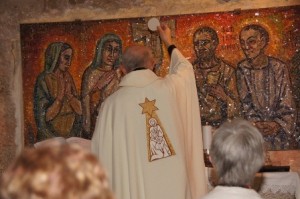 |
Mass, Monday 19 March, beneath the Basilica at Bethlehem, (St. Jerome might have prayed and celebrated Mass here.)
Those on our pilgrimage, who were not really engaged with ‘Churchy’ things, came to all the Masses, and this fact makes me reflect on the question that the Mass is many things to many people, with many different layers and meanings:
-
Perfect union with God through Jesus Christ who died and rose again for us.
- A chance to pray, be quiet, and be in union with God, as best as I may, with all my troubles.
- Something that cannot really be understood, or explained, because it is just the ‘right thing to do’ in certain circumstances – such as a pilgrimage ‘in the Footsteps of Jesus’.
- Being together, with a group of pilgrims, who have been guided, and led, through all the ‘ups’ and ‘downs’ of life, as we face things every day of our lives, and in the light of Jesus’ example in facing things that happened to him, in the places where they took place.
- A social activity with friends but with that important religious overtone.
Of course, in Bethlehem, we visited the spot where Jesus was born. You have to go down stairs, in this ancient Basilica of the Nativity, uniquely not destroyed by the Persian invaders in 641 AD, and now a bigger Church. There is an altar, with a big star underneath it: traditionally, that is where Jesus was born.
(May I add a rider here that, in the Holy Land, it is not really important whether the spot is the exact place where an event took place; the important thing is that it certainly did happen, and in that area! This question arises again and again in the Holy Land, for many different biblical events; the lack of importance regarding the exactitude question is also a common and refreshing feature).
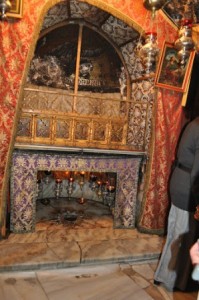 |
Traditionally, the Place Where Jesus Was Born
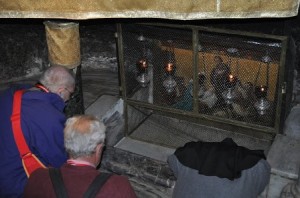 |
Where Jesus Lay in the Manger. (Three people on their knees – one, a nun, praying earnestly)
Prayer should surround, and penetrate, our lives; the Mass is essential, but not sufficient. In the Gospel, Jesus says “pray always”, (Luke 21: 36), and, in the letter to the Ephesians, one finds the same idea “Pray in the spirit at all times”, (Eph 6: 18). This cannot mean praying, in the usual sense of the word, with hands joined, heads down, eyes shut – in total communion with God, for when we drive the car, we can pray; similarly, when we cook, go shopping, read a book, have a conversation, or do any normal thing, we can pray at the same time. Who was it that prayed at all times? Jesus, himself, as he was in communion with God, and his will, at all times. The aim of our Christian life is to ‘put on Christ’ (Gal 3: 27), and we can participate in the behaviour of Christ, in the way we do ordinary things, if He is alive in us. In that sense, IN HIM, everything we do becomes a prayer. There is a great need for Christ to grow in people, for prayer to become constant, and the ‘present state’ of the Holy Land highlights these needs. When Christ Jesus is present in people, and among them, one feels peace. In the Holy Land there is an obvious lack of it.
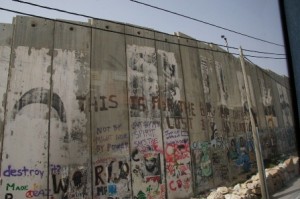 |
Close up of the Wall Surrounding much of the West Bank – The Section in Bethlehem
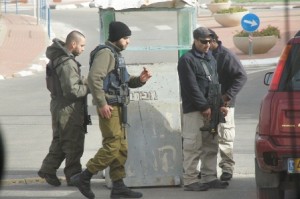 |
Israeli Soldiers at the Main Bethlehem Check Point
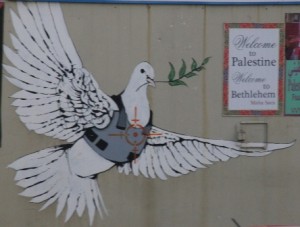 |
One of the Most Famous Graffiti on the Wall in Bethlehem – The Dove of Peace in Mortal Danger.
All pilgrims are affected by these sights, and by the tensions in the air. Most certainly, our group was – and because of this many feel the desire to pray. The Wailing Wall, which we visited, is a place of heartfelt prayer – a Jewish place of prayer, – and a place of prayer for all peoples. It is the outer retaining wall of the West of the Temple Mount that dates back to the Temple of Solomon, and the later, Herodian Temple of Jesus’ time. It remained standing after the Destruction of the Temple, by the Romans, in 70 AD; it is, therefore, a very holy site for Jews, and for all who are sons and daughters of Abraham – Jews, Muslims and Christians. Christians who are non-Semitic are children of Abraham spiritually, as we share the same faith as Abraham.
 |
Panorama of the Wailing Wall – Men’s Section; (Women’s Section is to the Right)
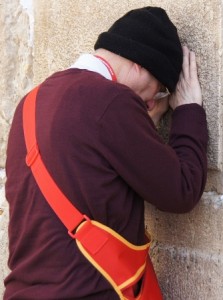 |
A Christian Praying at the Wailing Wall
We visited – at great length – the place where St. Peter betrayed Jesus. The knowledge that the great Saint Peter could behave in this way, can be greatly encouraging for us. In the spot where Peter was warming himself, by the fire outside the High Priest’s Palace, there is a series of expressive statues that catches the moment so well. Peter, who had so strongly told Jesus that he could never deny him, is here shown at his third time of denial, of any knowledge of who Jesus was; vehemently, stating he had never associated with Jesus. Peter’s behaviour was so like that of almost all of us, from time to time. Later on Peter would ‘begin again’ and be fully reconciled to the Lord, by the power of the Cross, that we had already seen the day before.
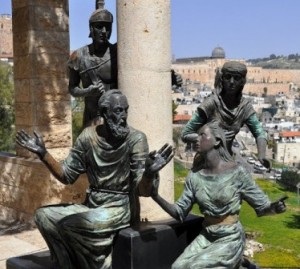 |
Peter Denies Jesus for the Third Time
Of course, we visited the Church of the Holy Sepulchre, and also walked the Way of the Cross, past the traditional Stations where Jesus carried his Cross, was helped by Simon of Cyrene, met his mother Mary, allowed Veronica to wipe his face with her towel, Fell Three Times, met the Women of Jerusalem; finally, where he was Stripped of his Garments, was Crucified and Died for our sins. Also, we saw the place of his Resurrection from the Dead. It was quite a feat, fitting all this in in the time available, and all that, apart from the crowded alley-ways that lead up to the famous Church of the Holy Sepulchre. The time problem led us to face the reality of a lack of peace, even in the holiest place in the world, where Jesus was crucified.
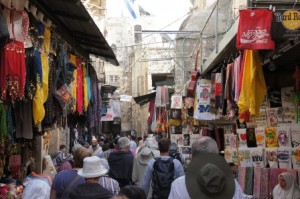 |
The Via Dolorosa when we were there
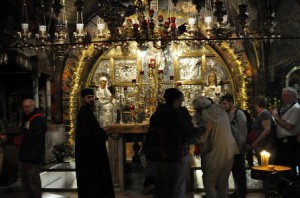 |
The Site of the Crucifixion – (note the concern on the face of the Orthodox monk, and the encouragement for our group to be quick and leave before the procession began)
In the picture above, beneath the altar, is the site of the Crucifixion of Jesus. Looking closely, one can see a person kneeling under the altar to feel, with his hand, the socket where the Crucifix upright was placed. This could be called the holiest place in the world – the place where our redemption took place. It should be a place of peace and concord, but, for us, it was a place of challenge and disquiet. For one thing, we had to queue for a long time to enter, first the place of Jesus’ burial, and from where he rose from the dead. The place of the burial, and Resurrection of Jesus, was in a brand-new burial place that belonged to Joseph of Arimathea: “Now there was a garden in the place where he was crucified, and in the garden there was a new tomb in which no one had ever been laid. And so, because it was the Jewish day of preparation, and the tomb was nearby, they laid Jesus there.” (John 19: 41-42). He was crucified on Golgotha, which is above the ‘garden’, as the place where his tomb is located, is named. People say the best way to describe it, is like a quarry: above is the crucifixion site. Below, in the quarry base, and hewn into the rock, is the burial chamber. The entire site, in two levels, is now covered by the Church of the Holy Sepulchre.
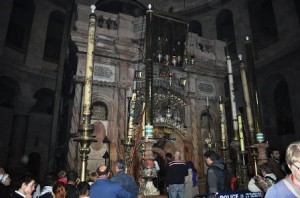 |
The Building Surrounding the Tomb of Jesus – (Only five people can enter at a time and there is always a long queue to enter – it was the first place we visited in the Church of the Holy Sepulchre.
The other thing was that we were finding ourselves in a very tight time-frame. We had arrived at about 2.45pm, in the Shrine of the Holy Sepulchre, and a Catholic Procession and Devotions were scheduled for 4.00 pm. By the time all members of our group had visited the places of Burial and Resurrection, it was around 3.50 pm, and some were still to venerate the Site of the Crucifixion. However, the Sepulchre was getting ready for the Catholic procession and vespers. We heard bells ringing, and, suddenly, a ‘shouting match’ was to disturb the peace. Our entire group was allowed to pass through. The ‘hullabaloo’ was because, one Christian pilgrim, in particular, also wanted to be allowed up the steps, to venerate the Crucifixion, but the Franciscan authorities had decided the entry point must close, after our group. Two Christians – one a good and consecrated Franciscan, to boot, all but came to blows. They raised their voices, very loudly, in a moment of intense anger and conflict. Yet, on this very spot, a great event had taken place – an event intended to be the focus for peace and reconciliation, for the whole world. It provided every one of us, with food for thought.
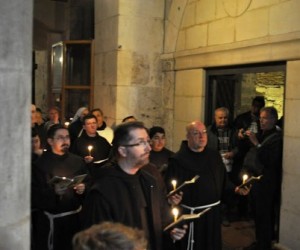 |
Daily Catholic Procession, 4.00 pm Tuesday 20th March 2012,
It was precisely this disunity, disharmony, and self-will, for which Jesus lovingly gave his life, allowing himself to be, utterly, cut off from God, emptying himself from his own desires, for the good of all. We were grateful that events had let us to complete this important part of the pilgrimage, and we could pray for the Peace of Jerusalem, in that difficult moment where there was a distinct of lack of peace. This included praying for the frustrated, and very vocal pilgrim, who, for all we knew, may never be able to return to this holy spot again; he had not been able, when it came to the moment, to venerate his Lord and Master’s place of Crucifixion. I wondered what I would have done, in his situation, and realised that, in different circumstances, I might easily have been so insistent in trying to get what I wanted. I could have behaved in a similar way. It should be noted that, in order to keep good order the young and burly Franciscan had to stop him doing what he wanted.
To pray for the peace of Jerusalem means, at the end of the day, to pray that I am always at peace, and I suppose, it must mean that Jesus, in his love and wisdom, humility and goodness, has come to live in me, for his glory, and the good of all. There is so much healing needed in our world; this obvious need is because of the lack of peace, the anger, the self-centredness, in us human beings. The many wars, conflicts, broken personal relationships, and all the divisions we experience, have their origins in the lack of peace and harmony, both within individuals, and among them. The only remedy lies in Love, growing in each person, and among people – the challenge of life! Love is God, the Word of God, who dwells in, and among us, as we put on Christ, more and more, thus removing our own ego. God does work the miracle; certainly, he did for us, during those days in the Holy Land.
The final photograph shows our group bar one, just before entry into the Holy Sepulchre Church, getting ready for an official photo of all, on some steps just outside the entrance.
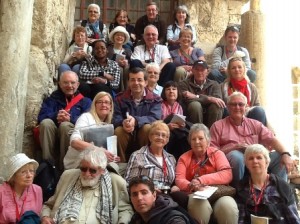 |
To circumvent the problem of disrupted formatting in the e-mail posting of the blog, readers are advised to visit the main blog site.

No comments